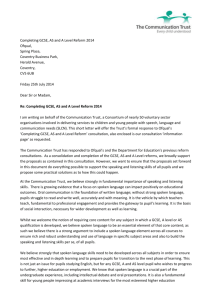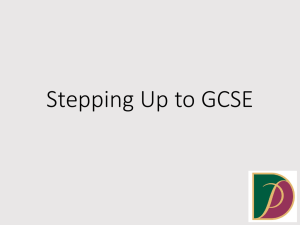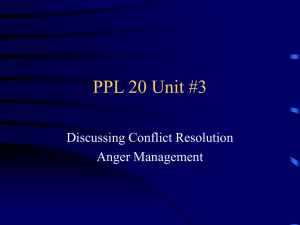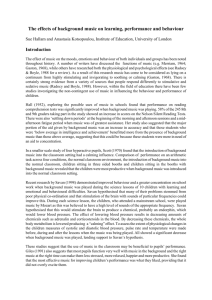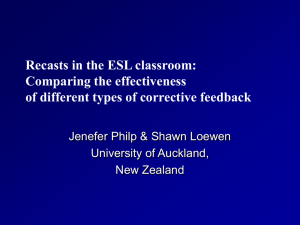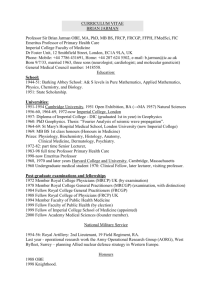communication
advertisement
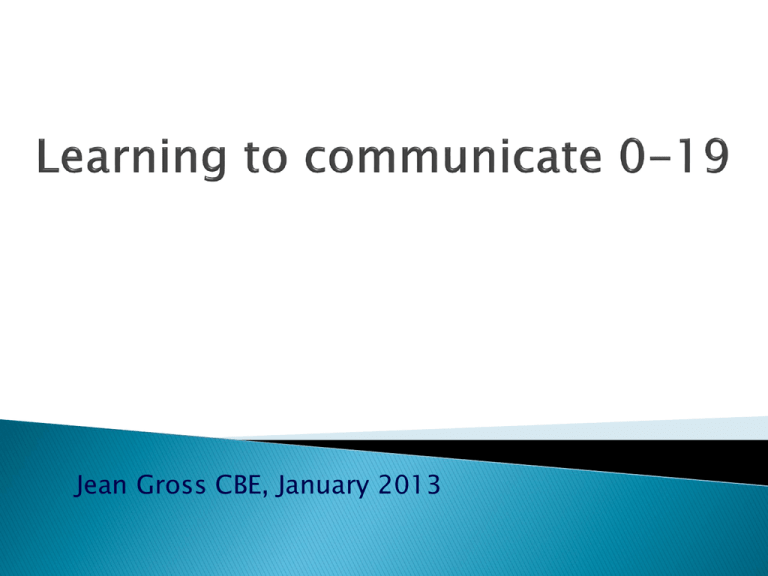
Jean Gross CBE, January 2013 Aims • Language and the brain • Why communication and language matter – the links with learning and behaviour • Share some effective practice from across the country The brain is hard-wired for language Behave! But I am have! Binocular vision Central auditory system Habitual ways of responding Language learning Emotional control Peer social skills ‘Sensitive periods’ in early brain development High Low 0 1 2 3 4 P.O. Svanberg Sept 2010 5 6 74 What does this say about communication development? • http://www.youtube.com/watch?v=apzX GEbZht0 A bit of science – predictors of good language development • Amount of language spoken to child • Conversational turns – the ‘serve and return’ • Singing nursery rhymes, sharing books, reminiscing about events • Lack of background noise • Child to child speech – engaging in joint planning, negotiating conflicts, providing explanations , telling stories • The way we talk – following child’s lead and commenting on their topic of interest, recasts and expansions TV as background noise Roulstone et al , 2011 Investigating the role of language in children’s early educational outcomes, Research Report DFE-RR134 The amount of time television (adult and child programmes) was on in the home when child was under two predicted achievement at school entry. As this time increased, so the child’s score at school entry decreased. A bit of science – predictors of good language development • Amount of language spoken to child • Conversational turns – the ‘serve and return’ • Singing nursery rhymes, sharing books, reminiscing about events • Lack of background noise • Child to child speech – engaging in joint planning, negotiating conflicts, providing explanations , telling stories • The way we talk – following child’s lead and commenting on their topic of interest, recasts and expansions Commenting Oooooo.... What’s that? I hope.... What colour is it ? What noise does it make? I wonder..... Expansions and recasts Context Child Typical adult response Much better if...... 5 year old looking at book about sea creatures Look at that whale What else can you see? It’s a giant blue whale , I think. Swimming in the ocean. 3 year old watching television Its Direman Sam No… Yes, Fireman Fireman Sam Sam’s coming to the rescue Aims • Language and the brain • Why communication and language matter – the links with learning and behaviour • Share some effective practice from across the country The scale of the problem 1 in 10 children has a long term and persistent language difficulty The scale of the problem More than 50% of children in some areas have language and communication difficulties De-contextualised formal talk • BICS- Basic Interpersonal Communication Skills (around two years to develop) • CALP- Cognitive Academic Language Proficiency (may take five to seven years to develop) Informal He hit me – he’s over there. Decontextualised The boy with a red jacket hit me. He’s standing by the farthest school gate. Poor communication skills impact on... Mental health Educational achievement •Vocabulary at 5 a powerful predictor of GCSE achievement Behaviour/vulnerability 2/3 of 7-14 year olds with serious behaviour problems have language impairment Criminality 40% of 7 to 14 year olds referred to child psychiatric services had a language impairment that had never been suspected Disadvantage Cycle Employability 47% of employers say they can’t get recruits with the communication skills they need 65% of young people in young offender institutions have communication difficulties Children from low income families lag behind high income counterparts by sixteen months in vocabulary at school entry The links to attainment • Research in one local authority found that children achieving below Level 2 in Reading and Writing at the end of KS1 had an average standardised score of only 75 on a test of oral language skills – 11 points less than those who achieved Level 2+. There was no difference between the groups on nonverbal intelligence The links to attainment • At KS2 there was an even bigger gap – of 19 points - between the language skills of those who achieved Level 4+ in English and those who didn’t (Gross, 2002) The Effects of Weaknesses in Oral Language on Reading Comprehension Growth (Hirsch, 1996) Reading Age Level 16 15 High Oral Language in 14 Kindergarten 13 5.2 years difference 12 11 Low Oral Language 10 in Kindergarten 9 8 7 6 5 5 6 7 8 9 10 11 12 Chronological Age 13 14 15 16 The links to attainment • For Year 5 children with poor reading comprehension, an intervention to boost oral language skills made more difference to reading comprehension than an intervention directly teaching reading comprehension skills (Snowling, 2010) Ofsted • ‘In the most effective schools, inspectors saw teachers thread rich opportunities for speaking and listening into lessons. In turn , this led to improved standards of writing’ (Annual report, 2010) • ‘A common feature of the most successful schools in the survey was the attention they gave to developing speaking and listening’(Removing Barriers to Literacy, 2011) Ofsted ‘Where inspectors saw links between oral language, reading and writing in lessons, standards at GCSE English Language were higher’ (Excellence in English, 2011) Poor communication skills impact on... Mental health Educational achievement •Vocabulary at 5 a powerful predictor of GCSE achievement Behaviour/vulnerability 2/3 of 7-14 year olds with serious behaviour problems have language impairment Criminality 40% of 7 to 14 year olds referred to child psychiatric services had a language impairment that had never been suspected Disadvantage Cycle Employability 47% of employers say they can’t get recruits with the communication skills they need 65% of young people in young offender institutions have communication difficulties Children from low income families lag behind high income counterparts by sixteen months in vocabulary at school entry Vocabulary at age 5 has been found to be the best predictor of whether children who experienced social deprivation in childhood were able to ‘buck the trend’ and escape poverty in later adult life ..but it’s what you do not what you earn that matters The child’s communication environment (the early ownership of books, trips to the library, attendance at pre-school, parents teaching a range of activities and the number of toys and books available) was a more important predictor of language development at two, and school entry ‘baseline’ scores at 4 than socio- economic background Roulstone et al (2011)Investigating the role of language in children’s early educational outcomes DFE RR134 Getting the message Inspectors will be looking at the extent to which • pupils develop a range of skills, including reading, writing, communication and mathematical skills, and how well they apply these across the curriculum’ • reading, writing, communication and mathematics are well taught Getting the message • All teachers, whatever subject they teach, must be able to promote ‘articulacy’ as well as literacy (Current professional standards for teachers) • Early Years Foundation Stage ‘prime’ area • National Curriculum? New primary National Curriculum – letter from Michael Gove • ‘Pupils will be taught to read fluently and develop a strong command of the written and spoken word’ • ‘We have included statements on the importance of spoken English in the new draft Programmes of Study for mathematics and science’ • ‘We will continue to consider how best to ensure that spoken language development is embedded across the curriculum as a whole, for example through curriculum aims.’ Used most, taught least? Listening Speaking Reading Writing Learned first second third third Used most next to most next to least least Taught least next to least next to most most It may feel like being asked to do the impossible … Aims • Language and the brain • Why communication and language matter – the links with learning and behaviour • Share some effective practice from across the country 0.0 0.2 0.23 0.18 0.1 0.25 0.24 Primary school effectiveness 0.26 Pre-school effectiveness Key Stage 1 HLE 0.7 Early years HLE Family SES 0.4 Fathers education 0.8 Mother’s education Family income 0.5 Birth weight Early Development al Problems 0.3 Gender Effect size Effect sizes for KS2 English 0.76 0.69 0.6 0.47 0.39 0.34 0.29 Take-home shoe-boxes Twinkle, twinkle little star • The rhyme • A card star to thread with wool • Star finger puppet • Biscuit recipe and star cutter • Glow-in-the-dark stars • Star kaleidoscope Dad’s reading challenge: ‘It can’t be true, can it?’ I really enjoyed coming home from work, knowing that my son had brought a story sack home from preschool for our bedtime story. Adventure Den Rainbow Den SEAL ideas... ‘talk homework’ • Loves and hates • When are the times when you get on best as a family...and fall out? • Talk about your dream home • Can you remember the day that I was born? • The best/worst thing that happened to me today was... • What cheers you up when you feel down? And in school? • A place to talk • A reason to talk • Support for talk A place to talk It doesn’t have to be expensive © Elizabeth Jarman © Elizabeth Jarman © Elizabeth Jarman Good practice • A place to talk • A reason to talk • Support for talk A reason to talk Technology • Podcasting and school radio ( have a look at Grove FM) • Easispeak microphones, Talking tins, talking postcards, story sequencers (TTS) • IPad apps Show me….Explain everything • Skype Class discussion ‘Classrooms where teachers talk less and children talk more. Classrooms where teachers scrap the mechanistic reliance on hands-up , ask more open-ended questions (why? how?), give thinking time, make space for collaborative conversations and oral rehearsal of answers, and then always ask pupils – rather than us – to comment upon the answer they have just heard.’(Barton, 2011). Good practice • A place to talk • A reason to talk • Support for talk Support for talk • Talk for writing • BT’s All Talk and Talk Gym • Teaching the skills of groupwork Support for talk Thinking Together approach • Teaches pupils how to hold a reasoned discussion, tackling problems in groups through talk. • The approach has been rigorously evaluated using experimental and control groups. There were significant impacts on attainment in science and maths, and in non-verbal-reasoning. Listen ‘Ear in Camden and Islington From caveman to spaceman Objectives: -To be able recognise how communication has developed over time. - To begin to practice effective communication In this lesson you will be learning through: 1. Watching a cartoon clip on communication 2. Class discussion 3. Reading a comic story about good communication 4. Listening to a song about communication 5. Assessing your speaking and listening skills Keywords Communication Effective Conversation skills Objectives: -To learn that you don’t have to agree with other people’s views, but that you should respect different opinions -To understand that conversations are more successful when both people can give their opinions and are listened to In this lesson you will be learning through: 1. Watching a film clip then class discussion Keywords 2. Writing on a questionnaire Conversation 3. Paired work to see who has the same opinions as you 4. Small group work about your favourite conversation topics Opinion listening Camden and Islington Vocabulary building My Dad’s been in one of those.... STAR – Select, Teach, Apply, Review Too easy Goldilocks words Too hard Everyday wordsones a child might use to another child Not too easy and not too hard, but just right Likely to be encountered again Average adult has a good knowledge of this word Average adult does not have much knowledge of this word Highly topicspecific STAR - Select Too easy Children Toys Goldilocks words Petticoat Hoop Too hard Gruel Workhouse Teaching vocabulary Phonological Semantic meaning Orthographic (Written form) Grammatical Motor programme What it sounds like Begins with: Sound: Letter: Number of syllables: Rhymes with: Ends with : Sound: Letter: What it means Where do you find it? How does it feel? What does it look like? Sign/symb ol What category is it? What do you do with it? Put it in a sentence Words that go with it Reformulate, elaborate, comment Child Typical adult response Much better if...... She were going on at me She was OK, she was going on at going on at you.... , or you … OK, she was going on at you, criticising you.. ’, or ‘OK, she was going on at you. I wonder what that was about?’ Additional interventions • Talk Boost : average progress 18 months over four month period • Talking Partners : 18 months progress compared to 5 for control group, over 10 weeks • TalkingPartners@Secondary : All pupils demonstrated improvement on standardised scores on Clinical Evaluation of Language Fundamentals (CELF)after ten-week intervention Aims • Language and the brain • Why communication and language matter – the links with learning and behaviour • Share some effective practice from across the country Free resources for practitioners and parents www.thecommunicationtrust.org. uk/resources www.talkoftheschool.org.uk All Talk from BT – teaching speaking and listening / communication skills , including GCSE and A level the really useful /). • Philosophy for children www.sapere.org.uk • Cambridge University’s Thinking Together approach www.thinkingtogether.educ.cam.ac.uk) • Talk Boost www.ican.org.uk • Talking Partners and TalkingPartners@Secondary www.educationworks.org.uk
